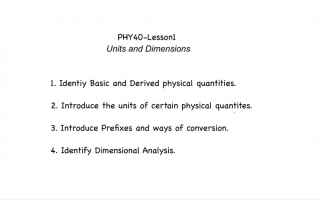PHY40-Lesson1
Units and Dimensions
1. Identiy Basic and Derived physical quantities.
2. Introduce the units of certain physical quantities.
3. Introduce Prefixes and ways of conversion.
4. Identify Dimensional Analysis.
Physics is the study of Nature, Matter, and Energy.
To start with physics we have to know what we call by Physical Quantities
Physical Quantities
Basic
Derived
Table 1 SI Base Units
Base Quantity → Base Unit → Symbol
Length → meter → m
Mass → kilogram → kg
Time → second → s
Temperature → kelvin → K
Amount of a substance → mole → mol
Electric current → ampere → A
Luminous intensity → candela → cd
Examples;
The length of a football field is 120 m.
The physics book has a mass of 1 kg.
The electric current flowing into the house is around 2 A.
Derived quantities are derived from basic quantities through combining them in different ways such as by multiplying and dividing.
Some examples on derived units are
Derived Quantity → Unit
Velocity → [m/s]
Area → [m²] [m x m]
Volume → m3
Density → Kg/m3
Force → Kg x m/s2 or N (Newton)
Acceleration → m/s2
Pressure → N/m2
Energy → J (Joules)
Power → J/s or Watt
The length of a football field is 120 m
The height of khalid is 167 cm
The distance from Abu Dhabi to Al ain is 150 km Unit
Dimensional Analysis
Physics is described by equations such as
Force = mass x acceleration
momentum = mass x velocity
velocity = displacement / time
Both sides of the equation should have the same unit. This is what we call by Dimensional Analysis.
Check whether the following formulas are dimensionally consistent?
d=distance [m]
v= velocity [m/5]
t= time [s]
a= acceleration [m/5a]
F= Force [kgom/5a]




